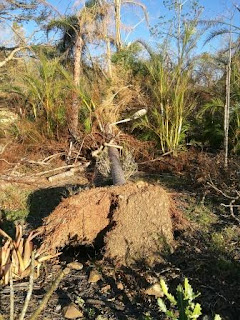It was time for a change of scenery from the Whitsundays so on New Years day we set off in Delvy for a trip down south. The Great Inland Way extends from Cooktown in Far North Queensland to Sydney, the capital of New South Wales. We joined the tourist trail from west of Mackay through coal mining country at Clermont, home of the world's largest seam of steaming coal. It was a hot day with the bluest sky and whitest clouds I have ever seen, creating a magnificent backdrop to the vast, brown land. Every so often stark rocky outcrops broke the monotony of the flat landscape, adding interest as we burnt the kilometres.
 |
| On the road to Clermont |
Crossing the Tropic of Capricorn it was onwards to Emerald, the heart of the Central Highlands; named after the surrounding green fields and not the famous Sapphire gems found in the area.
 |
| Rest stop outback Queensland |
The small outback towns of Springsure and Rolleston were next, and after getting lucky with finding a fuel store open on a public holiday, we decided to look at
Carnarvon Gorge within the spectacular wilderness of Carnarvon National Park. Now summer is definitely not the time to visit due to the extreme heat, but as we were passing by the turnoff we thought why not. It's about 720 kilometres north west of Brisbane, so we are hardly going to come by this way again in a hurry. The 41 kilometre stretch from the main road is in the process of being completely sealed but still goes through a few creek crossings, and when the summer rains come they may be impassable. The white sandstone cliffs are visible in the distance as we wind our way to the visitor area: funnily enough we were the only ones there when we pulled up on dusk. Surrounded by countless eastern grey kangaroos and towering eucalyptus trees and native palms, we settle in for a long, hot, insect ravaged night. The eerie orange glow from the emergency Telstra public pay phone seems out of place in this completely natural setting.
 |
| Eastern Grey kangaroo with joey |
We set off for a dawn stroll along the main walking track, crossing Carnarvon Creek and climbing up through blackened woodland and grass trees, catching glimpses of the infamous steep sided gorge. Already it was hotting up (forecast was for 38 degrees), so we backtracked to Delvy to prepare for another big driving day.
 |
| Carnarvon Gorge National Park |
 |
| Carnarvon Creek crossing |
 |
| On the main walking track, Carnarvon Gorge National Park |
The stretch from the main road turnoff to Injune was the most scenic so far in outback Queensland, with a variety of wildlife to keep us entertained: emus, wedgetail eagles and very large goannas. This is cattle and timber country. We stopped for a Driver Reviver cuppa at the cypress pine log cabin Visitor Information Centre at Injune, then headed for the large service town of Roma. The accidental discovery of Australia's first oil and gas reserves catapulted Roma onto the world stage and subsequently the town boasts quite a number of heritage listed buildings. We stocked up on air conditioning belts whilst here - at least the relative humidity was down a few percent from the Whitsundays but it was still hot!
 |
| Sandstone cutting between Rolleston and Injune |
We follow the Balonne River from Surat to St George, the fishing capital of inland Queensland, then onto cotton town Dirranbandi, home to nearby
Cubbie Station, the largest privately operated irrigated cotton farm in the world. It's big country out here with lots of room to move.
Dusk was descending a little later the farther we moved south, so we took advantage of the extra light and kept driving. Kangaroos hovered in the scrub alongside the road but strangely seemed to have good road sense. No roadkill littered the tarmac; instead scores of bird flocks darted out of roadside grasses as we approached. With recent rains there was plenty of grass seed to feed on.
We crossed the border into New South Wales, just south of Hebel, a typical Queensland outback village and where the Kelly Gang quenched their thirst at the local pub. I felt like I was coming home. Pink and orange coloured the sky as we pulled off the highway to the entrance of
Lightning Ridge, our camp for the night.
 |
| Queensland/New South Wales border on the Great Inland Way |
 |
| Entrance to Lightning Ridge |
An early start as we were keen to get to our destination in Bathurst. The towns became a blur: Walgett, Coonamble, Gulargambone, Gilgandra, all hugging the Castlereagh River; and then through the more familiar towns of Dubbo, Wellington, Orange, to finally arrive in Bathurst, my former home town.
 |
| Stretching the horses by the Castlereagh River, Gilgandra |
 |
| Driving shift |
 |
| Central West NSW between Orange and Bathurst |
Total kilometres in three days: 2000. Total fuel cost: $370.
Now to relax and enjoy the company of old friends and family.


























































